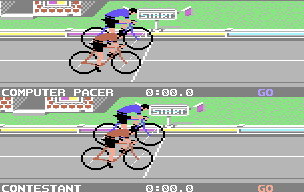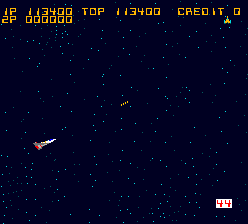Coming straight from Hang-On, a motorbike game that plays well with a modern steering wheel setup despite looking nothing like the original controls, we have two motorcar racing games that absolutely do not play well with a modern steering wheel setup despite looking very much like the original controls. Like Pole Position, these games use a free-spinning, non-centering wheel, and MAME simply does not provide a good way of mapping this to a standard racing wheel.
It's too bad, because otherwise I have the perfect setup for these games - uniquely for the time, they employed triple monitors for a panoramic view, and I have a curved ultrawidescreen, which still needs letterboxing to fit the 4:1 aspect ratio, but nevertheless affords me a much bigger field of view than I'd get on a 16:9, or the downright tiny one I'd get on a 4:3 screen. And my spinner equipped control panel, which I had used to an decent effect in Pole Position, wasn't so great here - in Pole Position you can do without analog throttle, but in TX-1, you definitely need it.
The way I wound up playing will sound odd when I describe it, but it kind of works - I set up my racing pedals and stick shift in front of my ultrawide monitor, but not the wheel - I used my mouse to steer instead!
Game 425: TX-1
A direct evolution of Namco's Pole Position, on paper, TX-1 seems like it should be even better - you have that triple-monitor setup, higher resolution graphics, more varied scenery, a more realistic driving model, and a longer, more complex course with branching checkpoints and eight possible endpoints all over the world, which I'm certain influenced OutRun's design.
Unfortunately, some of these points work against it. The "more realistic driving model" isn't realistic at all - just punishing. I never made it past three checkpoints.
Part of the problem is that while the graphics engine does some fancy pants stuff like tunnels, banked roads, and parallax backgrounds, it, like Pole Position (and Hang-On) relies on scanline trickery to distort the road into curves and bends, and just isn't equipped to render the sort of hairpin turns that it wants to.
And so the turns are visually confusing as they twist and warp. Going too fast through a track segment will cause you to lose grip and get tossed to the side and likely wipe out, and I had a consistently difficult time reckoning just how fast I could get away with, so I'd drive on the side of caution, which is a luxury that the strict time limit does not afford you.
But then there's the traffic, which can begin to downright clog the roads after the first checkpoint. The slightest touch means a spinout or fatal collision, their hitboxes are always bigger than they look, and your car just doesn't have the finesse to weave around your opponents during a turn, so I'd drive even more timidly and run out the clock waiting for an opening to speed up and pass.
I've played this game at ACAM too, in all its triple-monitor glory, but never did well there either. I should go back now that I've had some practice.
GAB rating: Average. Certainly a more ambitious game than Pole Position, but technical jank and weird handling keep it from being a better game. Perhaps it gets better if you can overcome the skill hurdle, but I didn't feel terribly motivated to keep trying.
Game 426: Buggy Boy
This one's more famous for its Commodore 64 port than the arcade original, which like TX-1 utilizes a three-screen panoramic view, and has the same PCB and pseudo-3D perspective. I kept my mouse-and-pedal steering setup.
Employing a cartoony visual style and outlandish animations that evoke Hanna-Barbera's Wacky Races, Buggy Boy's builds on TX-1's pseudo-3D wizardry, employing effects that in ways are more impressive than Sega's Super Scaler titles of the same year. Terrain that crests and dips, a camera that tilts up and down with appropriate perspective shift, weather effects, slanted side embankments, ridges, bridges, and so many pseudo-3D sprites, all of them smoothly-scaling with very little artifacting and no sprite flicker or z-fighting whatsoever. There's still some of TX-1's perspective weirdness, especially with sprites that jitter around in the distance before snapping into their proper place on the road as they come into range, and the overall look is a bit plain and unpolished compared to Hang-On, but the graphics engine is doing a whole lot more. If nothing else, Buggy Boy's clean visual style stands out among its pixelated sprite-scaling racing game peers to this day.
Befitting the cartoon aesthetic, Buggy Boy loses some of the harsh pseudo-realism of TX-1's driving model - your off-road vehicle's maximum speed is a lot lower, hairpin turns aren't a thing, and you no longer lose control when you turn too hard - the driving model simply won't allow you to turn more sharply than what your throttle allows.
But don't think Buggy Boy is easier than TX-1. Oh, no. If anything, it's harder, because these off-road tracks are cluttered with stationary obstacles arranged in ways that the Battletoads would struggle to swerve around. And that's before rival buggy drivers enter the scene!
 |
| Just... how are you supposed to hit that checkpoint? |
In the above video, I tour all five of Buggy Boy's courses in a single sitting, and do not come anywhere close to completing any of them, though I do manage to snag a high score in the first and easiest off-road circuit. There's some sort of flag-based scoring mechanic that I never really took the time to try to understand; collect five in a certain color order and a jingle plays for a little while which probably signals a bonus or a multiplier. Score optimization is a distraction from the main goal of beating the clock, which is plenty harsh already.
GAB rating: Average. Buggy Boy has a good amount of novelty, but I enjoyed slightly less than TX-1, which I didn't enjoy that much to begin with.









































